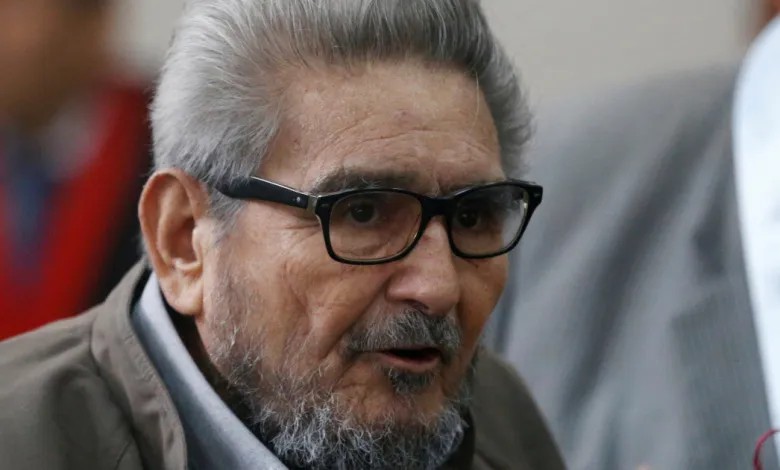The death in prison of 86 year-old Abimael Guzmán, the self-styled ‘President Gonzalo’ who was the leader of Peru’s Sendero Luminoso guerrilla group marks the end of the most violent chapter of that country’s recent history. LAB’s Nick Caistor looks back at Guzmán’s life and its impact on Peru.
He was a wild beast. After his capture in September 1992, he was put in a cage and shown to the public like an animal in a zoo. He wears a clean, black and white striped prison uniform, and has been given a number: Peru 1509.
The Peruvian state wanted to demonstrate that it dealt honestly and transparently with someone directly responsible for thousands of deaths. Abimael Guzmán, who called himself President Gonzalo, claimed he was the ‘fourth sword of Marxism after Marx, Lenin and Mao, and headed the millenarist guerrilla group Sendero Luminoso, responded as expected, howling, raising his fist, shouting defiance.
Guzmán had been at war with the Peruvian state since the early 1970s. After several stays in China, he was convinced he could spearhead a peasant revolution similar to Mao’s, or to those of Cuba and Vietnam.
He was arrested several times for taking part in protests against the military governments then ruling Peru, and went on to become one of the founders of the Communist Party of Peru-Sendero Luminoso.
The name of the group came from the writings of the early 20th century Peruvian Marxist thinker José Carlos Mariategui, who had declared that communism was the ‘shining path’ to a brighter future.
In 1980, when Peru was returning to civilian rule after 17 years, Sendero’s very first action was to burn ballot papers at a polling station in the Andean department of Ayacucho, where Guzmán had started out as a university lecturer in philosophy.
Guzmán and his colleagues thought that these rural Andean departments were the Peruvian state’s weakest point. Neglected over the centuries by rulers in far-off Lima, the lives of local Quechua-speaking peasant farmers had been made even worse by the military governments.
Guzmán’s strategy was to use violence to provoke a reaction from the authorities that would demonstrate to the poorest sectors of Peruvian society, especially in the countryside, that the ‘bourgeois regime’ of Peru’s state was based on oppression.
At first he and his comrades managed to recruit followers from some of the peasant communities, as well as students and some left-wing intellectuals in the cities.
This strategy of inciting violence succeeded only too well, especially after 1985 when Alan Garcia was elected president. He gave the armed forces, especially the counter-insurgency ‘Sinchis’ brigades, free rein to deal with Sendero.
Throughout the second half of the 1980s, this resulted in an increase in violence from both sides. Some peasant communities organised self-defence groups, so that the conflict often became like a civil war.
Terror comes to the cities
Although thousands of people were killed in the Andean provinces, it was only when Sendero Luminoso changed tactics and spread terror to Lima and other densely-populated centres that most Peruvians became alarmed by the threat.
While the army concentrated on dealing with Sendero by increasing repression, some units in the Peruvian police were using quieter detective methods to track down Guzmán and other leading members of the group.
So it was the police who in September 1992 succeeded in capturing Guzmán in a middle-class neighbourhood of the capital, where he had been living clandestinely all the time.
He was taken without a struggle, and put on trial in 1993. By then it was the autocratic Alberto Fujimori who was president, and he and his unofficial intelligence chief Vladimir Montesinos were quick to claim the credit for the arrest.
In that same year, despite signing a ‘peace treaty’ with the government and declaring that Sendero Luminoso members should lay down their arms, Guzmán was sentenced to life in prison, at the high-security naval base in Callao near Lima. Without his leadership, Sendero Luiminoso withered away, although a rump continued to operate in the remote Andean Huallaga valley, financing themselves through the illegal drugs trade.
In 2001 a government Truth and Reconciliation Commission concluded that as many as 70,000 Peruvians had died in the conflict between 1980-2000, and more than half a million people had been displaced by the violence. Almost half the deaths were attributed to Sendero.
Guzmán spent the remaining 29 years of his life in prison. In 2010 he married a second wife, Elena Iparraguire, who was allowed out of the women’s prison where she was also serving a life sentence, for the ceremony.
Guzmán’s death in September 2021 brought a dilemma for the new Peruvian president, Pedro Castillo: what to do with his remains? Fearing that if he were buried, his tomb might become a site of pilgrimage for Sendero Luminoso supporters, the government rushed legislation through Congress stating that terrorists dying in custody could be cremated. ‘Presidente’ Gonzalo’s ashes are like to be dispersed at sea off the Peruvian coast.
Main image: Peru News

